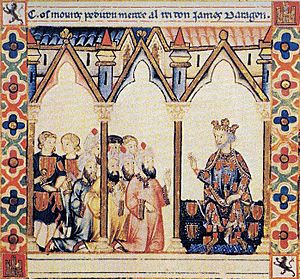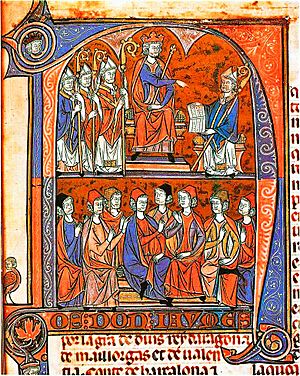James I of Aragon facts for kids
Quick facts for kids James I |
|
|---|---|

Detail from Vidal Mayor
|
|
| King of Aragon Count of Barcelona |
|
| Reign | 12 September 1213 – 27 July 1276 |
| Predecessor | Peter II |
| Successor | Peter III |
| Born | 2 February 1208 Montpellier |
| Died | 27 July 1276 (aged 68) Alzira, Valencia |
| Burial | Poblet Monastery |
| Spouse | Eleanor of Castile Violant of Hungary Teresa Gil de Vidaure |
| Issue among others... |
Violant, Queen of Castile Constance, Lady of Villena Peter III, King of Aragon James II, King of Majorca Isabella, Queen of France |
| House | Barcelona |
| Father | Peter II, King of Aragon |
| Mother | Maria of Montpellier |
| Religion | Roman Catholicism |
James I the Conqueror (born February 2, 1208 – died July 27, 1276) was a very important ruler in Spain. He was the King of Aragon, Count of Barcelona, and Lord of Montpellier from 1213 to 1276. He also became King of Majorca in 1231 and King of Valencia in 1238. His reign was the longest of any ruler in Spain at that time.
During his time as king, the Crown of Aragon grew a lot. It expanded north into Languedoc, southeast to the Balearic Islands, and south into Valencia. James made a special agreement called the Treaty of Corbeil with Louis IX of France. This treaty meant that France gave up any claims to Catalonia. In return, James agreed not to expand north into lands his father had lost. Instead, he focused on expanding south.
James played a huge role in the Reconquista, which was the Christian effort to retake land from the Moors in Spain. He was also a great leader and organizer. He created the Llibre del Consolat de Mar, a set of laws for sea trade. This helped Aragon become very powerful in the western Mediterranean Sea. James also helped the Catalan language grow by supporting Catalan literature. He even wrote his own life story, called the Llibre dels fets.
Contents
Early Life and Becoming King
James was born in Montpellier in 1208. He was the only son of Peter II of Aragon and Marie of Montpellier. When James was a child, he was used in political games. His father was fighting to help the Cathars against the Albigensian Crusaders, who were led by Simon IV de Montfort.
In 1211, James's father arranged for his two-year-old son to marry Simon de Montfort's daughter. He put James in Montfort's care. But soon, Peter II had to fight against Montfort. Peter II died in battle in 1213. Montfort wanted to use James to gain more power. However, the Aragonese people asked Pope Innocent III for help. The Pope made Montfort give James back. In 1214, James was given to the Pope's representative.
James was then sent to Monzón. There, he was looked after by the Knights Templar, a group of crusader knights. His great-uncle, Sancho, ruled the kingdom until James was older. The kingdom was in a bit of chaos. But in 1217, the Templars and loyal nobles brought the young king to Zaragoza.
In 1221, James married Eleanor, who was the daughter of Alfonso VIII of Castile. For the next six years, James faced many rebellions from the nobles. Finally, in 1227, James and the nobles made peace.
From 1230 to 1232, James talked with Sancho VII of Navarre. Sancho wanted James's help against his nephew. James and Sancho made a deal that James would inherit Navarre when Sancho died. But when Sancho died in 1234, the nobles of Navarre chose someone else as king. James disagreed, and the Pope had to step in. In the end, James accepted the new king of Navarre.
James wanted to create a strong state that stretched across the Pyrenees mountains. This would help balance the power of France. But this plan faced many challenges. In 1258, James signed the Treaty of Corbeil with Louis IX of France. This treaty was very important. It ended the conflict between them and made sure that France had no claims over Catalonia, including the County of Barcelona.
The Reconquest: Expanding South

After his plans for Navarre didn't work out, James turned his attention south. He focused on the Balearic Islands in the Mediterranean Sea. On September 5, 1229, James's army set sail from southern Catalonia. They had 155 ships, 1,500 horsemen, and 15,000 soldiers. Their goal was to conquer Majorca from its Muslim ruler.
James successfully conquered Majorca on December 31, 1229. Later, Menorca (in 1232) and Ibiza (in 1235) were also taken. The conquest of Majorca was mostly a Catalan effort, and many Catalans later settled there.
On September 28, 1238, Valencia surrendered to Aragonese rule. This happened after a long campaign that included the Siege of Burriana and the important Battle of the Puig. During the siege of Museros castle, some stories say James used gunpowder.
After the Treaty of Corbeil, James continued to fight the Moors in Murcia. He did this to help his son-in-law, Alfonso X of Castile. In 1244, James and Alfonso signed the Treaty of Almizra. This treaty set the borders for their expansion into Andalusia. It clearly defined the borders of the new Kingdom of Valencia.
Crusade of 1269
In 1267, Abaqa, a Mongol ruler, invited James to join a crusade with the Mongols. James sent a messenger to Abaqa, who returned with Mongol representatives in 1269. Even though the Pope and Alfonso X tried to stop him, James decided to go on a crusade. He made peace with the Sultan of Granada and gathered money for the journey.
In September 1269, James assembled his fleet in Barcelona. He was ready to sail east. But a big storm blew his ships off course. He landed in France and decided to return home.
James's sons, Pedro Fernández and Fernán Sánchez, continued the journey. They reached Acre in December. There, they saw the Egyptian Sultan Baibars showing off his military power. After seeing this, James's sons decided to return home.
Supporting Art, Learning, and Books
James I was a big supporter of art and education. He helped build and dedicate the Cathedral of Lleida. This cathedral was built in a mix of Romanesque and Gothic styles.
He also helped the University of Montpellier grow a lot. In 1245, he started a studium (a type of university) in Valencia. In 1263, James led a famous debate in Barcelona. It was between a Jewish rabbi named Nahmanides and a Christian convert named Pablo Christiani.
James was the first major supporter of writing in the Catalan language. He is even called "the first of the Catalan prose writers." James wrote or dictated his own life story in Catalan, called Llibre dels fets. This was the first autobiography written by a Christian king. It shows his ideas about being a king, examples of loyalty and betrayal, and medieval military strategies.
James also wrote the Libre de la Saviesa or "Book of Wisdom." This book contains wise sayings from many different thinkers, from King Solomon to his own time. It even includes ideas from Arab philosophers. During his reign, a Hebrew translator named Jehuda worked at James's court.
Even though James wrote prose and supported prose works, he also liked poetry. Many troubadours (poet-musicians) came to Aragon after the Albigensian Crusade forced them to leave southern France.
Succession and Death
James had many children, including some born outside of marriage. He showed a lot of favor to his illegitimate sons. This caused problems with the nobles and conflicts between his legitimate and illegitimate sons. When one of his illegitimate sons, Fernán Sánchez, was killed by his legitimate son Peter, the old king was satisfied.
In his will, James divided his lands between his sons by Yolanda of Hungary. His son Peter received the lands in mainland Spain. His son James received the Kingdom of Majorca. This included the Balearic Islands, the counties of Roussillon and Cerdanya, and the Lordship of Montpellier. This division often led to conflicts between his sons.
In 1276, James became very ill in Alzira. He gave up his crown and planned to retire to the Poblet Monastery. However, he died in Valencia on July 27, 1276. His mummified body was later found in 1856 when the monastery was being repaired. A photograph of the king was taken at that time.
Marriages and Children
James I had several marriages and many children.
His first marriage was in 1221 to Eleanor, daughter of Alfonso VIII of Castile. Even though this marriage was later ended, their son was declared legitimate:
- Alfonso (1229–1260), who married Constance of Béarn.
In 1235, James married again to Yolanda, daughter of Andrew II of Hungary. They had many children:
- Yolanda (1236–1301), who married Alfonso X of Castile.
- Constance (1239–1269), who married Manuel of Castile.
- Peter III (1240–1285), who became King of Aragon, Catalonia, and Valencia.
- James II (1243–1311), who became King of the Balearics and Languedoc.
- Ferdinand (1245–1250).
- Sancha (1246–before 1275), who died in the Holy Land.
- Isabella (1248–1271), who married Philip III of France.
- Maria (1248–1267), who became a nun.
- Sancho (1250–1275), who became Archbishop of Toledo.
- Eleanor (born 1251, died young).
James also married Teresa Gil de Vidaure in a private ceremony. He left her when she became ill. They had two sons:
These sons were recognized in his will as possible heirs if the main line of succession failed.
James also had children with other women:
- By Blanca d'Antillón: Fernán Sánchez (1240–1275), Baron of Castro.
- By Berenguela Fernández: Pedro Fernández, Baron of Híjar.
- By Elvira Sarroca: Jaume Sarroca (born 1248), who became Bishop of Huesca.
Images for kids
See also
 In Spanish: Jaime I de Aragón para niños
In Spanish: Jaime I de Aragón para niños



